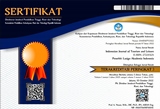Resource Efficient and Cleaner Production Assessment (RECP) in Pancoh Ecotourism Village, Regency of Sleman, Yogyakarta
Abstract
Keywords
Full Text:
PDFReferences
Agung, A., & Andriyani, I. (2017). Pemberdayaan Masyarakat Melalui Pengembangan Desa Wisata Dan Implikasinya Terhadap Ketahanan Sosial Budaya Wilayah ( Studi Di Desa Wisata Penglipuran Bali ). 9340, 1–16.
Agyeiwaah, E. (2019). Exploring the relevance of sustainability to micro tourism and hospitality accommodation enterprises ( MTHAEs ): Evidence from home-stay owners. Journal of Cleaner Production, 226, 159–171. https://doi.org/10.1016/j.jclepro.2019.04.089
Ahmad, F., Draz, M. U., Su, L., Ozturk, I., & Rauf, A. (2018). Tourism and environmental pollution: Evidence from the One Belt One Road provinces of Western China. Sustainability (Switzerland), 10(10), 1–22. https://doi.org/10.3390/su10103520
Berkel, R. Van. (2014). Cleaner Production Opportunities for Small to Medium Sized Enterprises Cleaner Production Opportunities for Small to Medium Sized Enterprises. (June).
Dewi, M. H. U., Fandeli, C., & Baiquni, M. (2013). Tabanan , Bali. Kawistara, 3(2), 117–226. https://doi.org/https://doi.org/10.22146/kawistara.3976
Dzulkifli, M., & Masjhoer, J. M. (2020). Analisis Efisiensi Sumber Daya dan Produksi Bersih di Desa Wisata Pulesari, Sleman, Yogyakarta. Jurnal Master Pariwisata (JUMPA), 6, 307. https://doi.org/10.24843/jumpa.2020.v06.i02.p04
Fandeli, C., & Mukhlison. (2000). Pengertian dan Konsep Dasar Ekowisata Chafid Fandeli*). In Pengusahaan Ekowisata. Fakultas Kehutanan Universitas Gadjah Mada.
Firdaus, Hardjosoekarto, S., & Lawang, R. M. Z. (2021). The Role of Local Government on Rural Tourism Development: Case Study of Desa Wisata Pujonkidul, Indonesia. International Journal of Sustainable Development and Planning, 16(7), 1299–1307. https://doi.org/10.18280/ijsdp.16071
Hamzah, A., & Khalifah, Z. (2009). Handbook on Community Based Tourism “How to Develop and Sustain CBT”.
Harianto, A., & Santoso, H. (2016). Pengaruh Medan Magnet Dengan Jarak. 17(2), 137–146.
Hastuti, Purwantara, S., & Khotimah, N. (2008). Model Pengembangan Desa Wisata Berbasis Kearifan Lokal sebagai Strategi Pengentasan Kemiskinan di Lereng Merapi Kabupaten Sleman Daerah Istimewa Yogyakarta. Anonim, 1–9.
Hens, L., Block, C., Cabello-Eras, J. J., Sagastume-Gutierez, A., Garcia-Lorenzo, D., Chamorro, C., … Vandecasteele, C. (2018). On the evolution of “Cleaner Production” as a concept and a practice. Journal of Cleaner Production, 172, 3323–3333. https://doi.org/10.1016/j.jclepro.2017.11.082
Lee, K. F. (2001). Sustainable tourism destinations: the importance of cleaner production. Journal of Cleaner Production, 9(4), 313–323. https://doi.org/https://doi.org/10.1016/S0959-6526(00)00071-8
Özbuğday, F. C., Fındık, D., Metin Özcan, K., & Başçı, S. (2020). Resource efficiency investments and firm performance: Evidence from European SMEs. Journal of Cleaner Production, 252. https://doi.org/10.1016/j.jclepro.2019.119824
Sesotyaningtyas, M., & Manaf, A. (2015). Analysis of Sustainable Tourism Village Development at Kutoharjo Village, Kendal Regency of Central Java. Procedia - Social and Behavioral Sciences, 184(August 2014), 273–280. https://doi.org/10.1016/j.sbspro.2015.05.091
Sunlu, U. (2003). Environmental impacts of tourism Local resources and global trades: Environments and agriculture in the Mediterranean region Bari : CIHEAM Options Méditerranéennes : Série A Environmental Impacts of Tourism. Séminaires Méditerranéens, 57, 263–270.
Syafi, M., & Suwandono, D. (2015). Tourism Village Planning Concept Approach Community Based Tourism (Case Study Bedono Village, Sayung, Demak). 11(2), 51–60. https://doi.org/10.14710/RUANG.1.4.51-60
UNEP. (2010). PRE-SME – Promoting Resource Efficiency in Small & Medium Sized Enterprises: Industrial Training Handbook. 141.
UNIDO. (2016). RECP Training National Tourism Experts Module 2 RECP Assessment. (March), 1–9.
UNIDO & UNEP(2010). Resource Productivity for Climate Action.
United Nations Industrial Development Organization. (2011). Unido Green Industry Initiative for sustainable Industrial Development. 2011, 1–44.
United Nations Industrial Development Organization, & United Nations Environment Programme. (2010). Enterprise-Level Indicators for Resource Productivity and Pollution Intensity. 1–56.
UNWTO. (2011). Key Energy Efficiency Solutions for SME Hotels.
Wang, Q., Yang, L., & Yue, Z. (2022). Research on development of digital finance in improving efficiency of tourism resource allocation. Resources, Environment and Sustainability, 8. https://doi.org/10.1016/j.resenv.2022.100054
DOI: https://doi.org/10.36256/ijtl.v3i2.274
Refbacks
- There are currently no refbacks.
Copyright (c) 2022 Indonesian Journal of Tourism and Leisure

This work is licensed under a Creative Commons Attribution-NonCommercial-ShareAlike 4.0 International License.
Indonesian Journal of Tourism and Leisure Indexed and Archieved By:

Indonesian Journal of Tourism and Leisure is licensed under a Creative Commons Attribution-NonCommercial-ShareAlike 4.0 International License.












